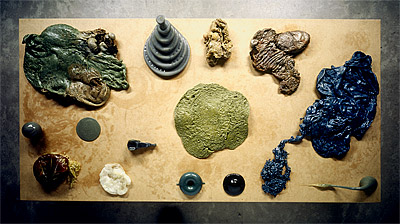Hany
ARMANIOUS
Egypt
1962
Australia from 1969
Snake oil
1994
synthetic polymer resin, bound pigment, composition board, steel rods
approx.
120.0 (h)
x 240.0 (w)
x 120.0 (d)
cm
Purchased 1994
National Gallery of Australia, Canberra
NGA 1994.1247.A-P
It is one thing to cast gold, bronze, iron, aluminium, wax or plaster. It is quite another to cast plastic. The first are traditional for jewellery, arms and armour, kitchenware, furniture, even sculpture. Cast plastics are for mass-produced items like buckets, toys and automotive components. The ‘inherent vice’ of many plastics and resins—their vulnerability to light and inability to last—may imply a lack of suitability for art, particularly sculpture, traditionally one of the most durable and monumental of disciplines. But the virtues of plastic—liquidity, implied movement and the ability to ‘capture’ a moment—are also incredibly compelling. Hany Armanious shows the why and how of plastics casting—and demonstrates, maybe, how and why not.
In Snake oil 1994 the objects seem to be shifting, multiplying, destroying themselves―and perhaps affecting us. Armanious discovered Hot Melt (a commercially produced synthetic resin) in 1993, and began to experiment with casting the substance in water. An exacting technique, water casting incorporates an element of chance into the creative process. As if to emphasise the material, and draw attention from his skills, Armanious sold the resulting ‘shapes’ by weight.[1] The artist offered his wares positioned equidistantly, arrayed on an apparently temporary folding table. Robert Leonard points out that collectively they suggest the results of an archaeological dig, a ‘fabulous landscape of fragments to pick through, play with and compare; an out-of-control chemistry experiment; a kindergarten wet area.’[2]
Snake oil was originally presented in four parts; the three other tables and their ‘specimens’ await another convocation.[3] The colour and condition of the objects, particularly en masse, and the associative quality of these forms, make for a highly disconcerting work―entrails? bodily secretions? some newly discovered creature from the bottom of the ocean?[4] The title refers to a sham medicine, a panacea or elixir, a quick fix for all problems. Armanious described Snake oil as a ‘physical three dimensional manifestation of a hallucinatory state’.[5]I don’t know about you, but reckon I’m only gonna buy one.
Lucina Ward
Curator
International Painting and Sculpture
National Gallery of Australia, Canberra
[1] For the Snake oil exhibition at Sarah Cottier Gallery, Sydney, March 1994, the ‘hotmelt’ was priced at $1550 per pound, and the individual items were numbered and identified as per a diagram. See NGA file 94/0086, folios 2 & 3
[2] Robert Leonard, in ‘Catalogue of errors’, in Heather Galbraith and Robert Leonard (eds), Morphic resonance: Hany Armanious, Institute of Modern Art, Fortitude Valley; City Gallery, Wellington, 2007, p 21
[3] The majority of ‘specimens’ were purchased and dispersed during the exhibition at Sarah Cottier Gallery, Sydney; the National Gallery of Australia holds two related works, from 1994, Proof and Field work. There is also another work from the same year at the Art Gallery of NSW, in which the ‘specimens’ are presented on plastic trays
[4] In 1998 Armanious produced Untitled snake oil. He cast pretty coloured vinyl into a series of regular drinking glasses and other fancy, pleasantly symmetrical forms, then presented those negative shapes on top of their moulds. The result was much more reassuring
[5] See Armanious’s statement for the 1994 exhibition, NGA file 94/0086, folio 8

